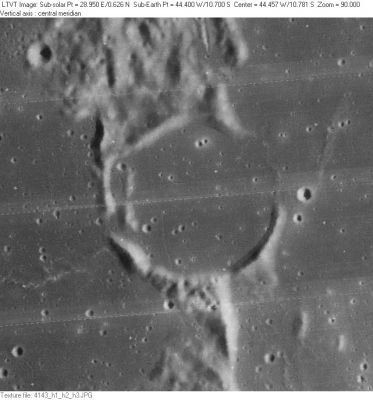Winthrop
Contents
[hide]Winthrop - on the western part of Letronne's rim
(formerly Letronne P)
|
Lat: 10.7°S, Long: 44.4°W, Diam: 17 km, Depth: 0.38 km, Rükl: 40 |
Images
LPOD Photo Gallery Lunar Orbiter Images Apollo Images
Maps
(LAC zone 75D2) LAC map Geologic map LTO map
Description
Letronne P (Winthrop) is a ruined crater, visible only as an incomplete rim crest cutting the western rim of Letronne. Winthrop has a diameter in the transition range from simple crater to that of more complex morphology. It may have originally been a hemispherical-shaped crater, like Theon Junior or it may have looked like Segers with multiple rim slumps onto the floor. In any case, flooding by Oceanus Procellarum mare lavas buried its prior history, leaving an incomplete rim that never should have been given a name. - tychocrater May 7, 2009
The location of Letronne P (Winthrop) is in (what I call) the Post-Apollo LTO-zone (LTO=Lunar Topographic Orthophotomaps). Many formations in the LTO-zone received new names. And indeed, WHY the remains of such incomplete craters received these new LTO-related names shall always be an unanswered question.
Although not in the LTO-zone, the very pronounced couple of large craters south of Bullialdus (Bullialdus A and B) are far better candidates! Both craters should receive officially recognized names A.S.A.P.!!! - DannyCaes Apr 29, 2017
Description: Wikipedia
Additional Information
Depth data from Kurt Fisher database
- Westfall, 2000: 0.38 km
Nomenclature
- John Winthrop (December 19, 1714 - May 3, 1779) was a distinguished mathematician, physicist and astronomer. Professor Winthrop was one of the foremost men of science in America in the eighteenth century, and his influence on the early advance of science in New England in particular was very great. Both Benjamin Franklin and Benjamin Thompson (Count Rumford) probably owed to him much of their early interest in scientific research. He corresponded regularly with the Royal Society in London — one of the first American intellectuals to be taken seriously in Europe. He was noted for attempting to explain the great Lisbon earthquake of 1755 as a scientific (rather than religious) phenomenon. His application of computations to earthquake phenomena after the great earthquake has formed the basis of the claim made for him as the actual founder of the science of seismology. He observed the transits of Mercury in 1740 and 1761 and journeyed to Nova Scotia to observe a transit of Venus. He traveled in a ship provided by the Province of Massachusetts - probably the first scientific expedition sent out by an American State.
- This replacement name for a formerly lettered crater was provisionally introduced on LTO-75D2 (for which it served as the chart title). The new name was approved "as now assigned and printed" in IAU Transactions XVIB (1976). - Jim Mosher
LPOD Articles
Bibliography
